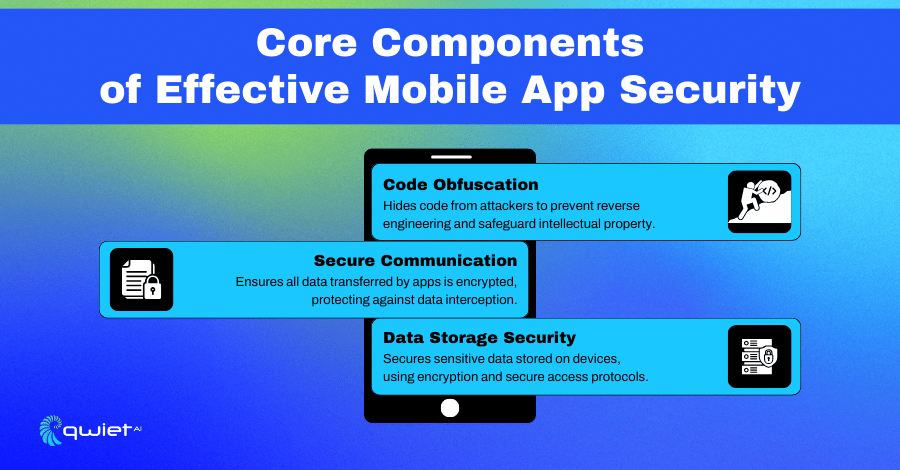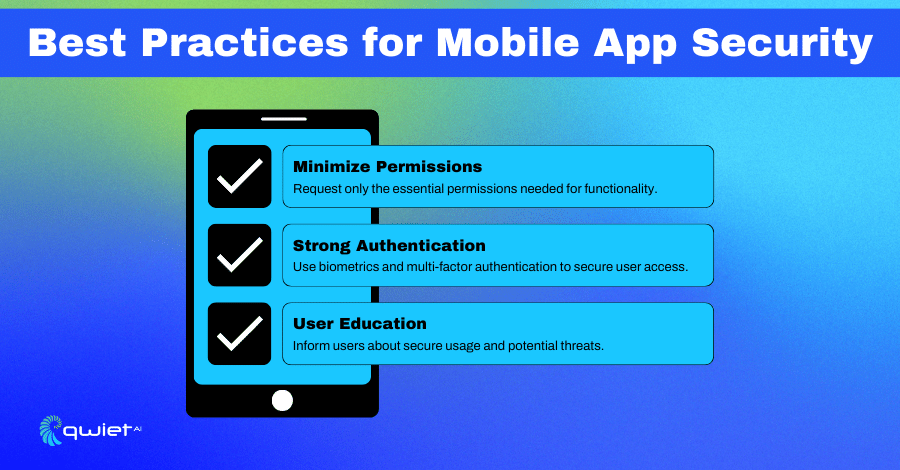What is Mobile App Security?
Mobile app security involves strategies and technologies to protect apps from malicious attacks and unauthorized access. In mobile applications, security is essential as these apps often handle sensitive personal and financial information.
Adequate security measures ensure that data remains confidential, integral, and available only to authorized users. This is crucial given that mobile devices are highly personal and always connected, providing numerous potential entry points for attackers.
Mobile app security is important because it helps safeguard users from data breaches and privacy invasions. By embedding security into the app development lifecycle, developers can prevent vulnerabilities that hackers could exploit. Protecting mobile apps is not just about guarding the data they process but also about maintaining user trust and compliance with global privacy regulations.
Challenges in Mobile App Security

Diverse Operating Systems:
One of the major challenges in mobile app security is the management of security protocols across different operating systems, such as iOS and Android. Each platform has its own set of security features and potential vulnerabilities.
Developers must tailor their security approaches to fit each system’s specific requirements and default behaviors, ensuring that security measures are effective and compatible across platforms.
User Behavior:
On iOS devices, risks often arise from users jailbreaking their devices to bypass manufacturer restrictions, potentially exposing them to unverified apps and malware. Developers must account for this by designing apps that detect and react to compromised operating system states.
For Android users, the flexibility of the OS allows for extensive customization, including installing apps from third-party stores. This behavior increases the risk of installing malicious apps, necessitating more stringent in-app security checks and user education on safe practices.
Data Leakages
In iOS applications, developers sometimes use the pasteboard to temporarily store data that users might want to copy and paste across different apps. However, if sensitive data like passwords or personal information is stored without restrictions, it can be accessed by any other app, leading to potential data leakage. To prevent this, developers can use the following approach to secure data in the pasteboard by making it accessible only within the app or clearing it when no longer needed.
| import UIKit class SecurePasteboard { func copyToPasteboard(data: String) { let pasteboard = UIPasteboard.general pasteboard.persistent = true pasteboard.setItems([[“com.yourapp.data”: data]], options: [UIPasteboard.Option.localOnly: true]) } func clearPasteboard() { let pasteboard = UIPasteboard.general pasteboard.items = [] } } |
In this code, UIPasteboard.general.setItems is used with the localOnly option set to true, ensuring that the data is available only within the app. The clearPasteboard method can be used when sensitive data is no longer required, ensuring that it does not remain accessible in the pasteboard after its intended use.
Android applications operate within a default sandbox that restricts access to the app’s data by other apps. However, improper implementation can lead to accidental data exposure. Developers can use content providers with proper permissions to securely share data between apps without exposing it to all apps. Here’s a basic example of implementing a secure content provider:
| import android.content.ContentProvider; import android.content.ContentValues; import android.database.Cursor; import android.net.Uri; public class SecureContentProvider extends ContentProvider { @Override public boolean onCreate() { // Initialization code here return true; } @Override public Cursor query(Uri uri, String[] projection, String selection, String[] selectionArgs, String sortOrder) { // Ensure that only authorized apps or components can access data throw new SecurityException(“Unauthorized access to secure data”); } // Implement other required methods like insert, update, delete securely } |
This example shows a basic structure where a ContentProvider is used but restricts access by throwing a SecurityException if unauthorized access is attempted. Developers must ensure that any method exposing data handles permissions and access control stringently, ideally allowing only whitelisted apps or components to interact with sensitive data.
Core Components of Effective Mobile App Security

Code Obfuscation:
Code obfuscation is a technique used to protect mobile app source code from being easily understood and tampered with by attackers. This process helps reduce the risks of reverse engineering, which can lead to the exposure of sensitive algorithms or the exploitation of security vulnerabilities. In iOS, developers might use a method such as XOR-ing characters in a string with a key to obscure sensitive information.
For instance:
| func obfuscateString(input: String) -> String { let key = “secretKey” return String(zip(input, key).map { $0.0 ^ $0.1 }) } |
This iOS code snippet demonstrates a basic technique to make strings harder to read, potentially safeguarding against direct extraction from the compiled app.
On Android, similar protection might involve renaming critical methods to something less obvious, thus making it harder for an attacker to pinpoint and manipulate crucial functionalities:
| public class SecurityFeatures { public void a() { // Originally login() // Authentication logic here } public void b() { // Originally encryptData() // Data encryption logic here } } |
Changing method names to generic labels makes the Android code less intuitive, complicating efforts to reverse engineer the application.
Secure Communication:
Ensuring data transmitted by mobile apps is encrypted and secure is critical to safeguard user data from being intercepted. On iOS, using the URLSession framework configured for HTTPS communication can enhance security:
| let session = URLSession(configuration: .default) let secureURL = URL(string: “https://api.example.com/data”) let task = session.dataTask(with: secureURL!) { data, response, error in guard let data = data, error == nil else { return } // handle received data } task.resume() |
This snippet ensures that all data exchanged with the server is encrypted, providing security against data breaches. Android developers can achieve similar results by using HttpsURLConnection or third-party libraries like OkHttp to enforce HTTPS:
| URL url = new URL(“https://api.example.com/data”); HttpsURLConnection connection = (HttpsURLConnection) url.openConnection(); try { InputStream in = new BufferedInputStream(connection.getInputStream()); // read the input stream } finally { connection.disconnect(); } |
The iOS and Android examples emphasize the importance of encrypted channels for data transmission, which minimize the risk of unauthorized data interception.
Data Storage Security:
Storing data securely on mobile devices is crucial to prevent unauthorized access. iOS developers often use the Keychain to store sensitive data securely:
| import Security let query: [String: Any] = [ kSecClass as String: kSecClassGenericPassword, kSecAttrAccount as String: “[email protected]”, kSecValueData as String: “password”.data(using: .utf8)! ] SecItemAdd(query as CFDictionary, nil) |
This code utilizes iOS’s Keychain services to store user credentials securely, ensuring that the data is encrypted and protected by the underlying security mechanisms of the operating system. Android developers can use EncryptedSharedPreferences for a similar purpose:
| SharedPreferences sharedPreferences = EncryptedSharedPreferences.create( context, “my_secure_preferences”, masterKey, EncryptedSharedPreferences.PrefKeyEncryptionScheme.AES256_SIV, EncryptedSharedPreferences.PrefValueEncryptionScheme.AES256_GCM ); // Securely store data sharedPreferences.edit().putString(“username”, “[email protected]”).apply(); |
By employing EncryptedSharedPreferences, Android apps can ensure that sensitive information like usernames and passwords are stored in an encrypted format, mitigating the risk of data theft even if the device is compromised.
Best Practices for Mobile App Security

Minimizing Permissions:
One effective way to enhance mobile app security is by minimizing the permissions an app requests to only those necessary for its functionality. This reduces the risk of sensitive data exposure and limits the damage that can be done if the app is compromised. For iOS apps, this means requesting permissions contextually, when the feature requiring the permission is accessed rather than all at once at first launch:
| import CoreLocation func getLocationAccess() { let locationManager = CLLocationManager() if CLLocationManager.locationServicesEnabled() { locationManager.requestWhenInUseAuthorization() } } |
This iOS code snippet demonstrates asking for location access only when it is needed, which not only helps with user trust but also adheres to best practices for privacy and security. Similarly, Android developers should also ensure permissions are kept to the minimum necessary:
| if (ContextCompat.checkSelfPermission(this, Manifest.permission.ACCESS_FINE_LOCATION) != PackageManager.PERMISSION_GRANTED) { // Permission is not granted ActivityCompat.requestPermissions(this, new String[]{Manifest.permission.ACCESS_FINE_LOCATION}, MY_PERMISSIONS_REQUEST_LOCATION); } |
In this Android example, the app checks if location permission is already granted before requesting it and only asks for it when performing actions where location data is essential. This practice keeps the app more secure and less intrusive.
Implementing Strong Authentication Mechanisms:
Implementing robust authentication mechanisms such as biometrics can enhance app security by ensuring that only authorized users can access sensitive features. In iOS, integrating Face ID or Touch ID is a straightforward process using the Local Authentication framework:
| import LocalAuthentication func authenticateUser() { let context = LAContext() var error: NSError? if context.canEvaluatePolicy(.deviceOwnerAuthenticationWithBiometrics, error: &error) { context.evaluatePolicy(.deviceOwnerAuthenticationWithBiometrics, localizedReason: “Access requires authentication”) { success, authenticationError in DispatchQueue.main.async { if success { // User authenticated successfully } else { // Handle failed authentication } } } } else { // Biometrics not available or configured } } |
This iOS code snippet shows how to use biometrics to authenticate users, providing high security for accessing the app’s sensitive parts. For Android, using biometrics can be implemented similarly with the Biometric API:
| BiometricPrompt biometricPrompt = new BiometricPrompt.Builder(this) .setTitle(“Biometric Login”) .setSubtitle(“Log in using your biometric credential”) .setNegativeButton(“Use account password”, this.getMainExecutor(), new DialogInterface.OnClickListener() { @Override public void onClick(DialogInterface dialogInterface, int i) { // User chose to use password } }).build(); biometricPrompt.authenticate(new BiometricPrompt.CryptoObject(cipher), new CancellationSignal(), getMainExecutor(), new BiometricPrompt.AuthenticationCallback() { @Override public void onAuthenticationSucceeded(BiometricPrompt.AuthenticationResult result) { super.onAuthenticationSucceeded(result); // User authenticated } }); |
This Android snippet sets up a biometric prompt that provides users with a secure and user-friendly way to authenticate. Utilizing these advanced security features ensures that sensitive information within the app remains protected.
Educating Users on Security Best Practices:
An often overlooked but crucial aspect of mobile app security is educating users about best security practices. Encouraging users to enable strong passwords, update the app regularly, and be cautious about the permissions they grant can significantly improve security.
Providing clear, accessible information within the app, such as tips during onboarding and reminders about security settings, can empower users to secure their data actively.
Engaging users with regular security updates and providing easy-to-understand tutorials can enhance their understanding and compliance with security measures, ultimately creating a safer environment for the user and the app ecosystem.
Conclusion
We’ve covered key aspects of mobile app security, including code obfuscation, secure communication, robust data storage practices, minimizing permissions, strong authentication mechanisms, and educating users on security best practices. Mobile app security is a dynamic field that requires continuous attention and updating to safeguard against emerging threats. To ensure your app is well-protected, consider partnering with Qwiet to proactively enhance your app’s security by booking a consultation with us today.
Read Next
No related posts.
About Qwiet AI
Qwiet AI empowers developers and AppSec teams to dramatically reduce risk by quickly finding and fixing the vulnerabilities most likely to reach their applications and ignoring reported vulnerabilities that pose little risk. Industry-leading accuracy allows developers to focus on security fixes that matter and improve code velocity while enabling AppSec engineers to shift security left.
A unified code security platform, Qwiet AI scans for attack context across custom code, APIs, OSS, containers, internal microservices, and first-party business logic by combining results of the company’s and Intelligent Software Composition Analysis (SCA). Using its unique graph database that combines code attributes and analyzes actual attack paths based on real application architecture, Qwiet AI then provides detailed guidance on risk remediation within existing development workflows and tooling. Teams that use Qwiet AI ship more secure code, faster. Backed by SYN Ventures, Bain Capital Ventures, Blackstone, Mayfield, Thomvest Ventures, and SineWave Ventures, Qwiet AI is based in Santa Clara, California. For information, visit: https://qwietdev.wpengine.com